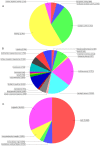Transcriptome sequencing and annotation for the Jamaican fruit bat (Artibeus jamaicensis)
- PMID: 23166587
- PMCID: PMC3499531
- DOI: 10.1371/journal.pone.0048472
Transcriptome sequencing and annotation for the Jamaican fruit bat (Artibeus jamaicensis)
Abstract
The Jamaican fruit bat (Artibeus jamaicensis) is one of the most common bats in the tropical Americas. It is thought to be a potential reservoir host of Tacaribe virus, an arenavirus closely related to the South American hemorrhagic fever viruses. We performed transcriptome sequencing and annotation from lung, kidney and spleen tissues using 454 and Illumina platforms to develop this species as an animal model. More than 100,000 contigs were assembled, with 25,000 genes that were functionally annotated. Of the remaining unannotated contigs, 80% were found within bat genomes or transcriptomes. Annotated genes are involved in a broad range of activities ranging from cellular metabolism to genome regulation through ncRNAs. Reciprocal BLAST best hits yielded 8,785 sequences that are orthologous to mouse, rat, cattle, horse and human. Species tree analysis of sequences from 2,378 loci was used to achieve 95% bootstrap support for the placement of bat as sister to the clade containing horse, dog, and cattle. Through substitution rate estimation between bat and human, 32 genes were identified with evidence for positive selection. We also identified 466 immune-related genes, which may be useful for studying Tacaribe virus infection of this species. The Jamaican fruit bat transcriptome dataset is a resource that should provide additional candidate markers for studying bat evolution and ecology, and tools for analysis of the host response and pathology of disease.
Conflict of interest statement
Figures








Similar articles
-
Discovery and biological confirmation of a highly divergent Tacaribe virus in metatranscriptomic data from neotropical bats.mSphere. 2024 Oct 29;9(10):e0052024. doi: 10.1128/msphere.00520-24. Epub 2024 Sep 11. mSphere. 2024. PMID: 39258931 Free PMC article.
-
Different but Not Unique: Deciphering the Immunity of the Jamaican Fruit Bat by Studying Its Viriome.Viruses. 2022 Jan 25;14(2):238. doi: 10.3390/v14020238. Viruses. 2022. PMID: 35215832 Free PMC article. Review.
-
The immune gene repertoire of an important viral reservoir, the Australian black flying fox.BMC Genomics. 2012 Jun 20;13:261. doi: 10.1186/1471-2164-13-261. BMC Genomics. 2012. PMID: 22716473 Free PMC article.
-
A metaanalysis of bat phylogenetics and positive selection based on genomes and transcriptomes from 18 species.Proc Natl Acad Sci U S A. 2019 Jun 4;116(23):11351-11360. doi: 10.1073/pnas.1814995116. Epub 2019 May 21. Proc Natl Acad Sci U S A. 2019. PMID: 31113885 Free PMC article.
-
A REVIEW OF NEOPLASMS IN A POPULATION OF JAMAICAN FRUIT BATS (ARTIBEUS JAMAICENSIS) UNDER HUMAN CARE.J Zoo Wildl Med. 2022 Sep;53(3):583-592. doi: 10.1638/2021-0170. J Zoo Wildl Med. 2022. PMID: 36214244 Review.
Cited by
-
Genes, inflammatory response, tolerance, and resistance to virus infections in migratory birds, bats, and rodents.Front Immunol. 2023 Aug 29;14:1239572. doi: 10.3389/fimmu.2023.1239572. eCollection 2023. Front Immunol. 2023. PMID: 37711609 Free PMC article. Review.
-
Studies on B Cells in the Fruit-Eating Black Flying Fox (Pteropus alecto).Front Immunol. 2019 Mar 14;10:489. doi: 10.3389/fimmu.2019.00489. eCollection 2019. Front Immunol. 2019. PMID: 30930908 Free PMC article.
-
Genome analysis reveals insights into physiology and longevity of the Brandt's bat Myotis brandtii.Nat Commun. 2013;4:2212. doi: 10.1038/ncomms3212. Nat Commun. 2013. PMID: 23962925 Free PMC article.
-
Immunological Control of Viral Infections in Bats and the Emergence of Viruses Highly Pathogenic to Humans.Front Immunol. 2017 Sep 11;8:1098. doi: 10.3389/fimmu.2017.01098. eCollection 2017. Front Immunol. 2017. PMID: 28959255 Free PMC article.
-
Transcriptomic Signatures of Tacaribe Virus-Infected Jamaican Fruit Bats.mSphere. 2017 Sep 27;2(5):e00245-17. doi: 10.1128/mSphere.00245-17. eCollection 2017 Sep-Oct. mSphere. 2017. PMID: 28959737 Free PMC article.
References
-
- Gunnell GF, Simmons NB (2005) Fossil Evidence and the Origin of Bats. Journal of Mammalian Evolution 12: 209–246.
-
- IUCN (2012) IUCN Red List version 2011.2: Tabel 3a - Status category summary by major taxonomic group (animals).
-
- Nery MF, Gonzalez DJ, Hoffmann FG, Opazo JC (2012) Resolution of the laurasiatherian phylogeny: evidence from genomic data. Mol Phylogenet Evol 64: 685–689. - PubMed
Publication types
MeSH terms
Grants and funding
LinkOut - more resources
Full Text Sources
Research Materials

